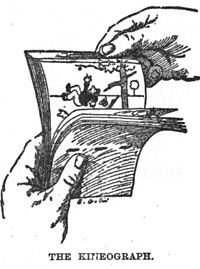Gebruiker:Tekstman/flipboek

Een flipboek (ook wel filmboek of duimbioscoop genoemd) is een boekje met een per pagina geleidelijk opeenvolgende reeks van illustraties, zodat, als de pagina's in snel tempo worden omgeslagen, de afbeeldingen een vloeiende beweging lijken te vormen. Flipboekjes zijn vaak kinderboeken, maar kunnen ook op volwassenen gericht zijn. Soms wordt in plaats van tekeningen gebruik gemaakt van foto's. Ze kunnen zelfstandig verkocht worden of als bijlage bij andere boeken of bij tijdschriften. Ook met software of websites kunnen digitale videobestanden in flipboeken omgezet worden.
Functionality[bewerken | brontekst bewerken]
Een flipboek is in beginsel een primitieve vorm van animatie. Evenals bij film is het concept gebaseerd op wat wel persistentie wordt genoemd they rely on persistence of vision to create the illusion that continuous motion is being seen rather than a series of discontinuous images being exchanged in succession. Rather than "reading" left to right, a viewer simply stares at the same location of the pictures in the flip book as the pages turn. The book must also be flipped with enough speed for the illusion to work, so the standard way to "read" a flip book is to hold the book with one hand and flip through its pages with the thumb of the other hand. The German word for flip book—Daumenkino, literally "thumb cinema"—reflects this process.
History and cultural uses[bewerken | brontekst bewerken]

The first flip book appeared in September, 1868, when it was patented by John Barnes Linnett under the name kineograph ("moving picture"). They were the first form of animation to employ a linear sequence of images rather than circular (as in the older phenakistoscope). The German film pioneer, Max Skladanowsky, first exhibited his serial photographic images in flip book form in 1894, as he and his brother Emil did not develop their own film projector until the following year. In 1894, Herman Casler invented a mechanized form of flip book called the Mutoscope, which mounted the pages on a central rotating cylinder rather than binding them in a book. The mutoscope remained a popular attraction through the mid-20th century, appearing as coin-operated machines in penny arcades and amusement parks. In 1897, the English filmmaker Henry William Short marketed his "Filoscope", which was a flip book placed in a metal holder to facilitate flipping.
Flip books are now largely considered a toy or novelty for children, and were once a common "prize" in cereal and Cracker Jack boxes. However, in addition to their role in the birth of cinema, they have also been an effective promotional tool since their creation for such decidedly adult products as automobiles and cigarettes. They continue to be used in marketing of all kinds, as well as in art and published photographic collections. Vintage flip books are popular among collectors, and especially rare ones from the late 19th to early 20th century have been known to fetch thousands of dollars in sales and auctions.
The first international flip book festival was held in 2004, by the Akademie Schloss Solitude in Stuttgart. Another international flip book festival was held in Linz, Austria in 2005.
The first flip book in stereoscopic 3D was published in September 2005 in "Stereo News" (www.cascade3d.org) and subsequently in "Stereoscopy" the Journal of the International Stereoscopic Union in December of 2005. (www.isu3d.org)
See also[bewerken | brontekst bewerken]
- Electrotachyscope
- Phenakistoscope
- Praxinoscope
- Strobe light
- Tachometer
- Thaumatrope
- Zoetrope
- Zoopraxiscope
- Mutoscope
External links[bewerken | brontekst bewerken]
- flipbook.info Includes demonstrative videos of antique flipbooks.
- History of Flip Books Informative historical information and images of old flip books
[[Category:Animation techniques]] [[Category:Books by type]] [[Category:History of film]]
